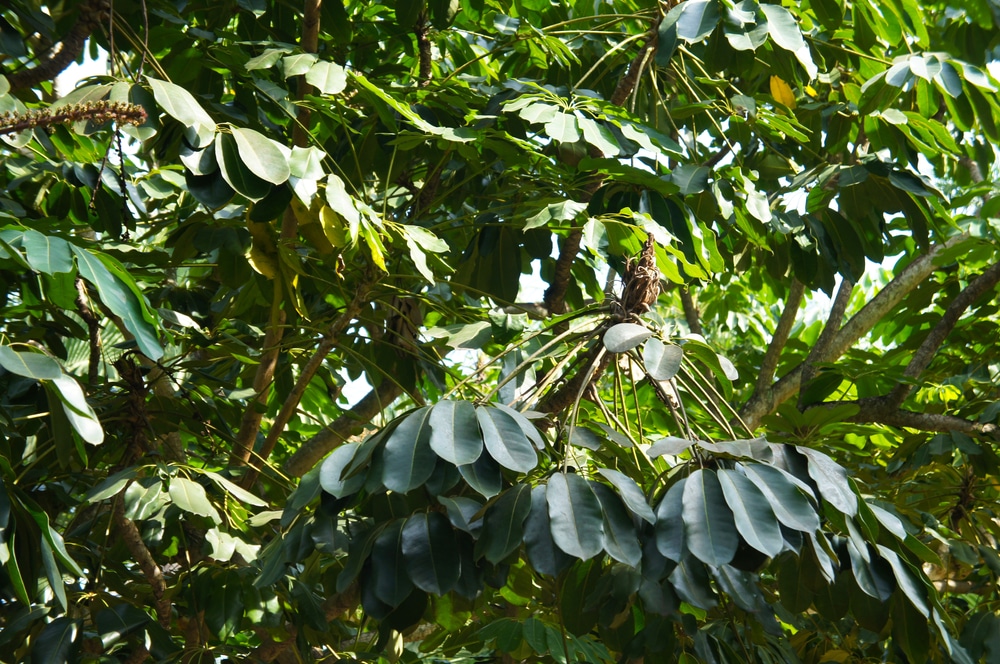Tupidanthus Calyptratus is a versatile plant that can be used as both a houseplant and in gardens. When kept as a houseplant, it typically grows to about 180 inches in height but if planted outdoors, it can grow up to even 480 inches.
This plant is a fast-growing one that does best in bright, indirect sunlight but can also tolerate low-light conditions. It is called Mallet Flowers because of the resemblance of its unique blooms to a mallet. Its drooping leaves that create a weeping appearance also make it distinctive.
| Botanical Name | Tupidanthus Calyptratus, formerly Schefflera pueckleri |
| Common Name | Mallet Flower |
| Plant Type | Perennial |
| Flower Color | Green |
| Size When Mature | 180-480 Inches |
| Bloom Time | Fall and Winter |
| Sun Requirements | Full Sun to Partial Shade |
| USDA Hardiness Zones | 9 – 11 |
| Soil PH Range | 6.0-6.5 |
| Soil Type | Rich, well-draining |
| Water Needs | Medium |
| Native Area |
Myanmar and India |
What You Need to Know About Tupidanthus Calyptratus
Despite their beautiful foliage and flowers, mallet flowers can be poisonous to animals, and humans too. It has been linked to nausea, kidney problems, tremors, and heart and respiratory issues.
Oral irritations, such as difficulty swallowing, drooling, and burning of the mouth, lips, and tongue might also be caused by this plant. It is important to keep this plant away from the reach of small children and pets.
This plant is easy to grow and does not require much care. Its leaves are flat and palmately-lobed, with red-stalked palmately-lobed ones that radiate out and then droop over.
The leathery cap of the flower drops off from late fall to winter, revealing the many green stamens. The common name Mallet Flower derives from the plant’s one-of-a-kind characteristic when the base becomes brown and resembles tiny mallets.
This plant is well-liked for its lovely foliage, which is attractive not only in bloom. When the flowers bloom, they provide a welcome splash of color in an otherwise drab landscape. The blooms last for several weeks, adding beauty and interest to any garden.
How to Care for Tupidanthus Calyptratus
Here’s everything you need to know about growing and caring for a thriving Tupidanthus Calyptratus:
Light
Tupidanthus Calyptratus is a plant that thrives best with plenty of sunlight. It requires full sun to partial shade. If it does not receive enough light, it may drop leaves and fail to grow properly. Make sure to place it less than 3 feet from a south-facing window to maximize its growth potential.
Water and Soil Needs
This plant prefers humid conditions and rich, well-drained soil. Tupidanthus Calyptratus is a relatively low-maintenance plant, but it can be susceptible to root rot if over-watered. A regular watering schedule must be established, allowing the soil to dry out before watering again.
Water moderately during growth and keep only moist to the touch in winter. During the growing season, allow the soil to dry between watering.
Temperature Requirements
This plant thrives in USDA zones 9-11 and is not tolerant to freezing temperatures. This plant does not do well in cold drafts, so make sure to keep it away from windows and doors during the winter months.
Ideally, a warm temperature between 65-75 degrees Fahrenheit is needed to help keep the plant happy and thriving.
Fertilizer
The best fertilizer to use on a Tupidanthus Calyptratus is a well-balanced fertilizer. It benefits from being fertilized monthly during the growing season. While it’s tempting to use a fertilizer that’s rich in nitrogen to help the plant grow quickly, too much nitrogen can actually result in fewer blooms.
A good balance of nitrogen, phosphorus, and potassium is what this plant needs to thrive and look its best.
Common Diseases
This plant is susceptible to leaf spot disease and may also be infected with anthrax. If your plant happens to contract these diseases, make sure to remove the affected leaves and destroy them.
Black leaves may also indicate that there is a problem with your plant. Leaves may turn black due to frost or cold damage so it is best to protect your plant from these conditions.
From time to time it may also be vulnerable to insect pests such as borer moth, red spider, scale insects, and thrips. This may become a problem if the plant is not kept healthy. To ensure the health of your plant, it is necessary to strengthen prevention and control. Spray pesticides when necessary.
Tupidanthus Calyptratus Propagation
This plant’s propagation is relatively easy and can be done through seed or by leaves or cuttings. The lower leaves are removed, and the branches are chopped off. The cuttings should be kept warm and moistened, and rooting is completed around 4-6 weeks later.

